Category ArchiveHubley
Animation Artifacts &Hubley &Models 29 Oct 2008 08:20 am
Doonesbury Models
- I have some of the model sheets that Gary Trudeau drew for the Hubley film, Doonesbury (which was done for CBS in 1977.)
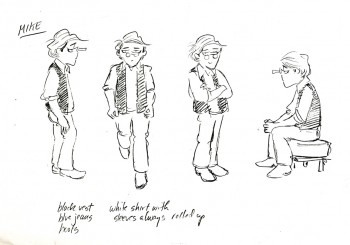 As I wrote once before, I had some problems with this production. It was the job I took immediately after completing Raggedy Ann & Andy. I was glad to be working with John Hubley again, and I helped on some of the prep for this show.
As I wrote once before, I had some problems with this production. It was the job I took immediately after completing Raggedy Ann & Andy. I was glad to be working with John Hubley again, and I helped on some of the prep for this show.
I was not a fan of the strip or Trudeau, and I know he wasn’t a fan of mine. Regardless, I would have walked through walls for John. Unfortunately, the walls which were covered with stunning artwork and paintings from past Hubley films, now displayed comic strips ripped from the newspaper and taped on top of the Hubley pictures. This annoyed me, of course.
But I continued layout of the show until one day when I was called into John’s office. He told me that he was about to go into hospital for a heart operation and expected to be back in about 3 weeks. I’d face a short lay off/break in work.
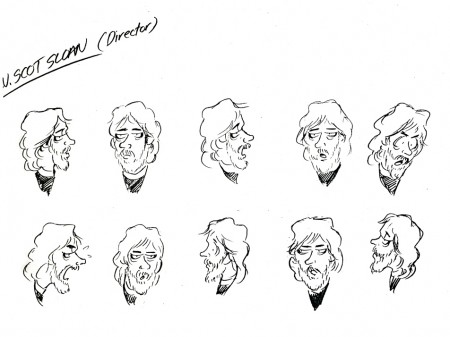
John didn’t come back. He died in the operation and ultimately Faith and Gary Trudeau went on to complete the film. I chose not to return.
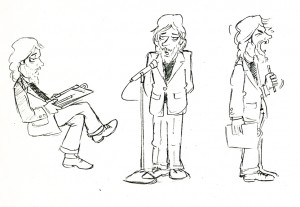 I worked with R.O.Blechman in putting together the PBS special, Simple Gifts. Tissa David also worked on that film. She went to work for Faith after she finished her segment. She told me that she couldn’t finish animating 100 ft. (abot a minute) a week without a fast assistant. I offered to help.
I worked with R.O.Blechman in putting together the PBS special, Simple Gifts. Tissa David also worked on that film. She went to work for Faith after she finished her segment. She told me that she couldn’t finish animating 100 ft. (abot a minute) a week without a fast assistant. I offered to help.
At night, after working all day for Bob Blechman, I assisted Tissa’s sequence and then did a couple of Ruth Kissane’s sequences that were too complicated for some of the novice people at Hubley’s. I wasn’t very connected to the studio and felt the distance.
The show aired on CBS and was nominated for the Oscar.
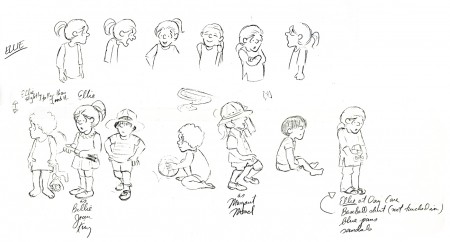
(Of course, all images enlarge when clicked.)
Animation &Hubley &Tissa David 22 Oct 2008 08:12 am
Tissa’s Glad Gladys
-Tissa David animated a lot of the Electric Company pieces for John Hubley. Hubley would design and write the spots, and he would get some real pros to do the tracks. In the case of this film, I believe it was the jazz legend, Billy Taylor, who wrote the music and did so for a number of Hubley’s Electric Co. films.
I’d like to post John Hubley’s LO drawings and follow it up with a few of Tissa’s animation drawings. John would usually do the loosest of layout drawings – usually in the presence of the animator as part of a discussion – and then hand it off to this person he trusted. Of course, the less he trusted the animator, the more he had to do in the LO.
In the case of this spot, Tissa received the following drawing. (That’s right ONE drawing.)
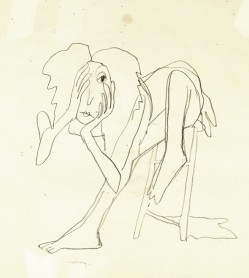
(If you click any of the images, they’ll
reveal the full animation drawing.)
If you enlarge the image, you’ll notice tape marks and pin holes where Tissa attached it to her wall.
Here’s a short sequence of drawings done by Tissa. The missing mouths are on a separate level. This piece is built on reuse done artfully.
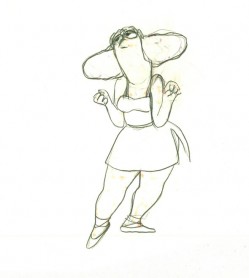 48
48 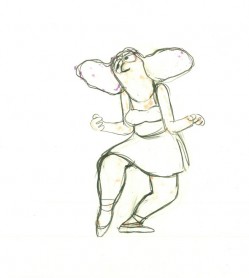 49
49
Here’s how the drawings looked when they were colored. They were colored on heavier paper. Sharpie outlines and marker coloring. The white background was all they used for the final. The animation carried the piece.
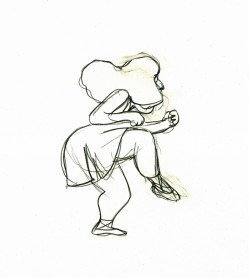 73
73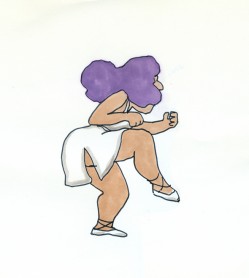 73
73Finally, here’s a copy of the film found on YouTube:
Animation &Hubley &repeated posts 18 Sep 2008 08:20 am
Moonbird revisited
In September 2006 I posted a couple of Bobe Cannon drawings from Hubley’s Moonbird. Let’s take another look:
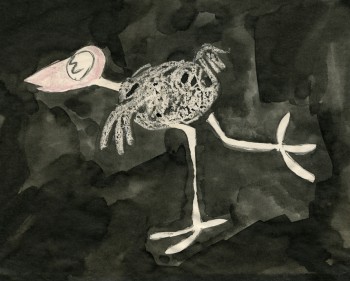 – Moonbird is one of the seminal films of 20th Century animation.
– Moonbird is one of the seminal films of 20th Century animation.
After John Hubley left UPA, where he helped explore the use of 20th Century graphics in animation, he formed a commercial animation company in Los Angeles. Apparently, with this new entity, John did less drawing and more producing. Trying to correct this problem, he closed the LA office and set up in NYC with Faith.
The studio in New York did commercials on a smaller scale. With a Guggenheim Fellowship of $8000, the couple produced a short film, Adventures of an * in 1957 and committed to doing one film a year for themselves. With this film, Hubley picked up where he’d left off at UPA. Exploration of modern art now took on the wildly successful Abstract Expressionists and told a non-verbal story using expressionist art.
The film Tender Game, done in 1958, told another non-verbal story using the song “Tenderly” to illustrate a romance, again, in expressionist art. This film, in some ways, feels like an outgrowth of Hubley’s work on the feature, Finian’s Rainbow.
In 1959, Moonbird took a giant leap forward. The art style borrowed from the expressionists, but used a method of double exposures to layer the characters into the backgrounds. Each animation drawing was painted black outside the border of its lines. Moonbird, the character, was colored with clear wax crayon and painted with black ink. The black resisted where the wax stood and gave a loose scribbled coloring. All of these painted drawings were photographed as double exposures, shot at less than 100%, to combine characters with Bgs.
The soundtrack involved an improvised track of two children, Mark and Ray Hubley, playing. These were recorded in sessions within a recording studio and massively edited down to create the final tracks.
Bobe Cannon animated the film with Ed Smith assisting. Ed inbetweened Bobe’s scenes and animated many others.
A variation of this became the Hubley method. There was usually someone working in the studio who did all inbetweens and animated some lesser scenes. A great way to break into the medium in a big way.
Some extremes by Bobe Cannon are posted below.
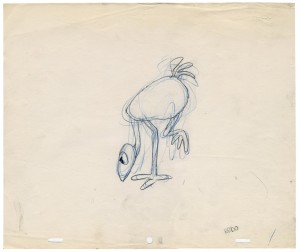
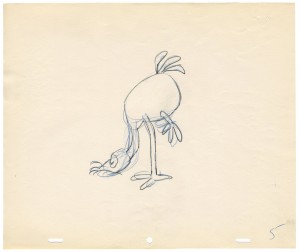
(Click on any image to enlarge.)
Here’s a link to a YouTube version of the film.
Animation Artifacts &Commentary &Hubley 01 Aug 2008 08:05 am
Everybody Rides – 2
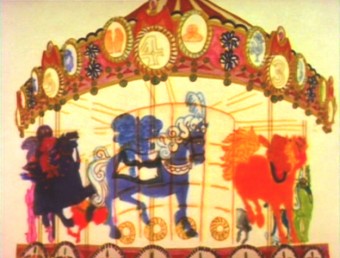 – We started slowly on Everybody Rides the Carousel. There was a six month schedule for about 72 mins of animation. Three half-hour original tv shows for CBS about 24 mins each. They’d air in the late summer of 1975 just prior to the start of the new tv season. Each show would air a day apart from the others – three nights in a row.
– We started slowly on Everybody Rides the Carousel. There was a six month schedule for about 72 mins of animation. Three half-hour original tv shows for CBS about 24 mins each. They’d air in the late summer of 1975 just prior to the start of the new tv season. Each show would air a day apart from the others – three nights in a row.
John and Faith spent a lot of time – a lot of time – at RCA studios on 45th Street. (It’s
____ The carousel was bottom lit & became soft focus.____-_ now an IRS office.) They recorded many of voices playing the numerous parts in their show. I tried to time meeting them there a couple of times hoping to meet some of the actors (I particularly wanted to see Jack Gilford in action. He was doing an hilarious part with his wife, playing a couple of cranky old people in a diner.) It didn’t work out that way, but I did see the facility and heard parts in process.
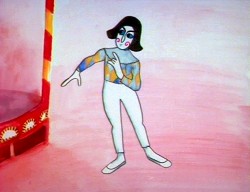 The key staff working IN the studio (not counting animators who would, for the most part, work freelance) included Ida Greenberg. Ida was a brilliant checker/coordinator who’d started back in the Florida days of the Fleischer studio. (She told me a few great stories about Gulliver’s Travels.) Ida was a great woman, with the thickest New Yowk accent, who never seemed to buckle under pressure. I grew very close to her. I tried after that to have Ida everywhere I worked. She led Raggedy Ann’s I&Pt and R.O.Blechman’s special._____________ Art Babbitt animated some of the mimes.
The key staff working IN the studio (not counting animators who would, for the most part, work freelance) included Ida Greenberg. Ida was a brilliant checker/coordinator who’d started back in the Florida days of the Fleischer studio. (She told me a few great stories about Gulliver’s Travels.) Ida was a great woman, with the thickest New Yowk accent, who never seemed to buckle under pressure. I grew very close to her. I tried after that to have Ida everywhere I worked. She led Raggedy Ann’s I&Pt and R.O.Blechman’s special._____________ Art Babbitt animated some of the mimes.
Kate Wodell was a student of the Hubleys at Yale. She was a talented artist who’d moved into production during the making of Cockaboody and continued on staff there. Sometimes she colored, sometimes she animated, sometimes she did whatever was necessary. This was exactly how I moved into the studio and loved the experience. She worked with Faith for many years after John died.
Earl James was an animator who’d worked in the backroom of many NY studios from Paramount to Terrytoons to NY Institute of Technology. He also had done some comic strip work.
Earl was given the carousel to animate. This came from a couple of elaborate drawings John did. Earl worked 16 fld. using a 96 drawing cycle. It gave us a lot of opportunity to move in tight or stay wide. However, it was a nightmare that took forever. Joe Gray was hired to assist Earl. (Joe started during the Terrytoons strike and never left. He was a lifetime assistant like a handful of other noted names in NY.)
This scene moved so slowly through production that I kept jumping in to assist as well. I was a fast assistant, but that carousel slowed even me down. 8 horses moved in perspective in a circle; you got to see 96 different rotating views of all the horses. I’d guess the scene took about 10 weeks to complete.
I was also doing layout and animation of a lot of connecting scenes throughout the production. These were scenes that would have to blend from one animator to another, or John had decided to go in tight for a closeup. In one case with Art Babbitt’s mime character, I was asked to change it from two’s to four’s with a dissolve technique John taught me (he said they’d used it on Fantasia.)
There were four people in my room, Earl, Joe, me and Mark Hubley. He worked alongside me for most of the film. He colored artwork given him by Ida, who was working in the larger room next door. Mark and I had a good releationship going back the many years I worked there. He joined the studio once he completed college. Emily Hubley worked alongside Kate and Ida.
Two younger, more experimental animators were brought in by John. Adam Beckett had made a name for himself with the films he was doing at CalArts.
Fred Burns was doing some incredible work at UCLA. They both were very different and added their unique touch.
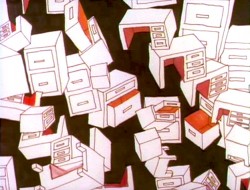
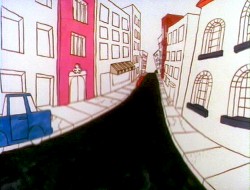
___________ Adam Beckett’s scenes included these two surreal images.
Adam did a scene a couple of scenes wherein office furniture floated about in a very complicated surreal cycle. Fred did this amazing scene of a roller coaster from the POV of the rider. He and I worked together a number of times after that, and we’ve stayed friends.
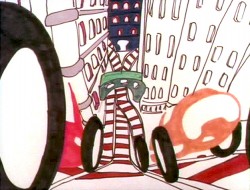
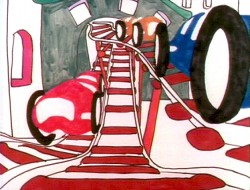
______________ Fred did this very elaborate sexual roller coaster.
I decided, last week, that I had a lot to say about this feature film. Hence, you’ll have to excuse me for reminiscing over the series of pieces I’m going to write. I also have some artwork – other than frame grabs – that I’ll try to share in future pieces.
Animation &Frame Grabs &Hubley 30 Jul 2008 08:08 am
Everybody Rides – 1
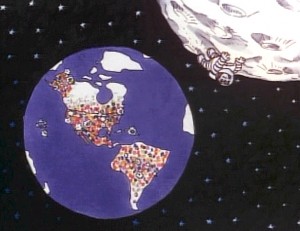 - Back in 1976, I was working on John Hubley’s Bicentennial flm, PEOPLE PEOPLE PEOPLE. This was a short film, about four minutes long, that had about a million scenes. It told the history of the US (from the standpoint of populating and overpopulating) beginning 17760 BC and ending in 1976 AD.
- Back in 1976, I was working on John Hubley’s Bicentennial flm, PEOPLE PEOPLE PEOPLE. This was a short film, about four minutes long, that had about a million scenes. It told the history of the US (from the standpoint of populating and overpopulating) beginning 17760 BC and ending in 1976 AD.
It started with some lengthy scenes. As the film moved on, the cuts came faster, until they hit about 6 frames apiece toward the film’s end. The final scene, from space, was the longest in the film.
There were no characters that appeared in any more than one scene. That meant that with each scene, there were new setups, new characters, new colors, new everything. As a result, it took much longer than other films and was a difficult one to pull off. But like all other Hubley efforts, it was fun. Tissa David, Jack Schnerk, Lu Guarnier, Phil Duncan and Bill Littlejohn animated it. I colored about 2/3 of the film and animated at least a dozen or two scenes (some really were only 6 frames – like that auto shot posted). I also assisted/inbetweened all of the animators.
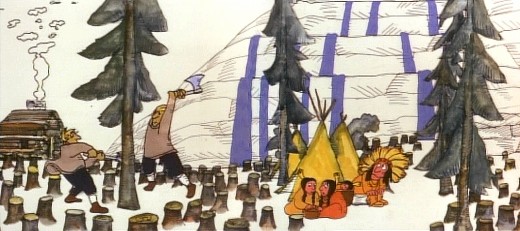
Swedes cut down all the trees in PEOPLE PEOPLE PEOPLE.
The studio, at the time, was buzzing because John and Faith had just sold a dream project to CBS. Everybody Rides the Carousel was an adaptation of Erik Erikson‘ 1956 book, Eight Stages of Development. Erikson was a psychologist who theorized that man goes through eight stages of development from birth to death, and he proceeds to break them down. The Hubleys took this book and broke these eight stages into horses on a carousel.
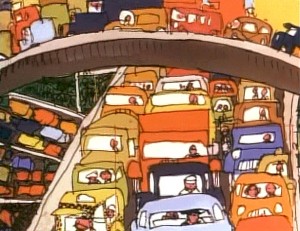 The three half hour Special shows for CBS would be about these carousel horses and the ride.
The three half hour Special shows for CBS would be about these carousel horses and the ride.
Each of the stages would be broken into two different subsets, and these would be depicted through stories which were roughly developed visually by John and Faith. Once the funding started to tricle in (about $450,000 for all three shows) they would cast their many actors and have them improvise in the recording studios to the storyboarded set pieces.
While those recordings progressed, the small studio staff was busied in completing animation, artwork and rendering of PEOPLE PEOPLE PEOPLE.
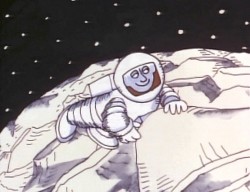
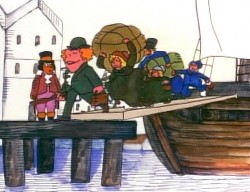
The man on the moon and the Irish immigrants.
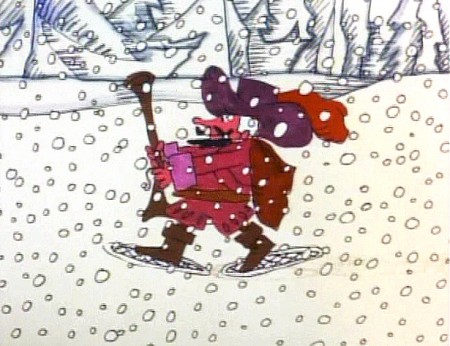
Jack Schnerk animated the French trapper sequence. There was such a rush
on the scene that I remember Jack bringing it in saying he hoped it would work.
He’d done two drawings of snow for the blizzard. Both wildly different from each other.
He asked me to ink them, then flop the drawings and ink them again.
He’d exposed the four drawings on fours. He also had the trapper with
snowshoes walking on fours. He felt it would help us feel a struggle in his
walking through the snowstorm. He felt the fours might add weight.
The scene worked beautifully, and was excellent the first time out.
Not quite the way they’d have done it at Disney. Tricks of the trade.
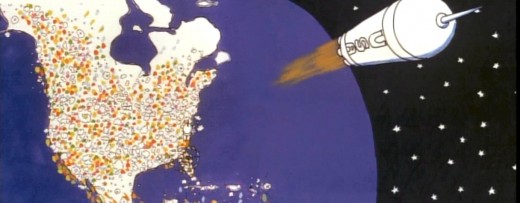
Tissa animated a majority of the film. The ending, the man going to the moon to escape
the overpopulated earth was hers. I have the drawings somewhere and will post some of them soon.
Commentary &Hubley &Photos 04 Jun 2008 08:14 am
Jazzy Show
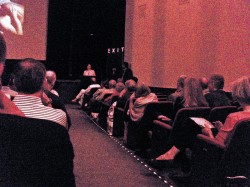 – On Monday night, there was a presentation at the Museum of Modern Art of a number of Hubley short films that highlighted their JAZZ SCORES series. The program was well organized by film curator, Josh Siegel.
– On Monday night, there was a presentation at the Museum of Modern Art of a number of Hubley short films that highlighted their JAZZ SCORES series. The program was well organized by film curator, Josh Siegel.
Emily Hubley presented the films at the start and had a couple of words about her parents’ work. She was joined in the audience by her sister, Georgia Hubley, and her brother, Ray Hubley. Their families were also present. Only Mark Hubley wasn’t able to make it down for the show. ________________________________Emily talking in front of the auditorium
The films were presented in clusters of composer.
Tender Game, with music by Ella Fitzgerald and the Oscar Peterson trio, led off the program. With a newly constructed print the colors dazzled with depth and beauty. You could see the texture of the paper in the backgrounds and the beautiful brush strokes. The art couldn’t have looked more stunning.
Three Dizzy Gillespie shorts followed:
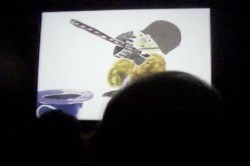 The Hat has an improvised voice track with Dudley Moore and Dizzy Gillespie. They also did the score – Dudley on piano, Dizzy on trumpet.
The Hat has an improvised voice track with Dudley Moore and Dizzy Gillespie. They also did the score – Dudley on piano, Dizzy on trumpet.
Date with Dizzy is a live action piece that promotes the “Storyboard” ads. A live action director, “Don Babbitt,” tries to get Dizzy and his group to perform a score to their animated ad. The ad was drawn and animated by R.O. Blechman.
____The Hat played on the big screen______Voyage to Next features Maureen Stapleton
_____________________________________and Dizzy Gillespie. Dizzy did the score with Dee Dee Bridgewater singing. (I did a lot of work on this one. I have a lot of Bill Littlejohn’s drawings, and I’ll show them off sometime soon.)
Following this, Benny Carter‘s widow, Hilma Carter, and Ed Berger, Carter’s biographer, introduced shorts that Carter scored.
Adventures of an * was the featured piece with a newly reconstructed print (I wrote about this here) and an out-of-this-world art exhibit of many backgrounds and cel paintings. (Actually cels weren’t used. The characters were colored on paper with crayon and wax and blackened all around their shape. This was then double-exposed into the backgrounds.)
Finally, Of Men and Demons, finished the night. This film was scored by the brilliant Quincy Jones, and the score is a major strong point. There is no dialogue, hence there are no voices heard. Tissa David animated a lot of this film and re-worked a lot of Art Babbitt‘s scenes in this film. Bill Littlejohn did much of the demons.
Tissa sat to my left along with her close friend Ruth Mane, who was a first class inker and checker in NY’s animation story. We worked closely at Raggedy Ann.
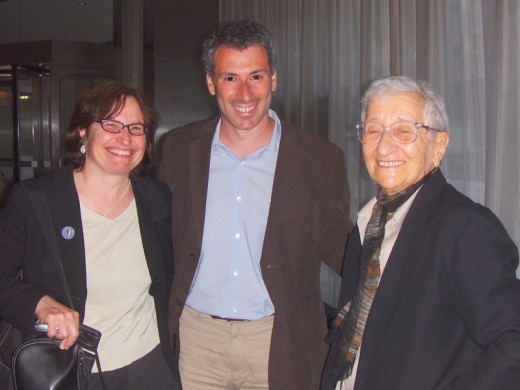
____Emily Hubley, Josh Siegel and Tissa David in the lobby of MOMA.
____I met them there when I arrived.
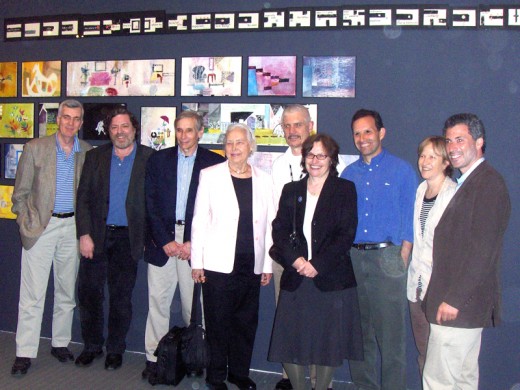
__A crowd after the screening.
__Left to right: John Canemaker, me, Ed Berger, Hilma Carter, Ron Magliozzi (Assistant
__Curator, Research and Collections, MoMA), Emily Hubley, Ray Hubley, Georgia Hubley,
__Josh Siegel (Assistant Curator, Department of Film, MOMA).
The screening was pretty much full, but I wouldn’t say the animation community was well represented. I saw a couple of young animators there including Tim Rauch and Emmett Goodman. Ray Kosarin, just back from viewing some 1700 films at Hiroshima’s prejudging, was also there and seemed charged by the Hubley films.
The museum had a dinner for some of the guests including John and me, Amid Amidi, the Hubleys and their families, as well as Hilma Carter and Ed Berger. Tissa had to leave right after the screening. It was a real treat of an evening.
Daily post &Hubley 31 May 2008 08:32 am
Hubley at MOMA and more
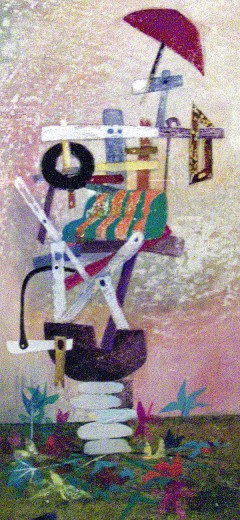 - On Monday, the Museum of Modern Art will continue its series of Jazz on Film (Jazz Score)with their first all animation program. This is a program of classic Hubley shorts. which feature jazz by such classic composers/musicians as Dizzy Gillespie, Quincy Jones, Benny Carter and others.
- On Monday, the Museum of Modern Art will continue its series of Jazz on Film (Jazz Score)with their first all animation program. This is a program of classic Hubley shorts. which feature jazz by such classic composers/musicians as Dizzy Gillespie, Quincy Jones, Benny Carter and others.
The program will be presented by Emily Hubley, Benny Carter’s biographer Ed Berger, and Benny’s widow Hilma.
The highlight of the program are MoMA’s newly and beautifully preserved prints of Adventures of an * and The Tender Game. Having seen the print of Adventures of an *, I can tell you it’s a treat. I saw the film originally projected back in 1963 when it was just seven years old, and this version is significantly better. I don’t think I’ve ever seen Tender Game in a good copy in all the many times I’ve seen it, so this is what my Monday will be about.
The show will start at 6:30pm in Theater 1 (The Roy and Niuta Titus Theater 1). It’ll run 100 mins.
Come to the theater a bit early and take a look at the exhibition in the lobby outside the theater. There’s an enormous amount of art beautifully displayed for you to see. It’s a treat, believe me. (I wrote about the opening of this exhibit and posted photos here.)
This is not the end of the animation in Jazz Score. These and other shorts will be screened with feature films:
- Carmen D’Avino’s Pianissimo – screening on June 5 and 9
John Canemaker’s Bridgehampton – screening on July 2 and 5
Zbigniew Rybczynski’s Plamuz (Music Art) – screening on August 7 and 9
Adam Beckett’s Sausage City – screening in September
Pierre Hebert’s Population Explosion – screening in September
You can check MOMA’s calendar to find out exact times.
_
- There are two sites I’d like to point out – again.
- I have to say that I’m just loving Mark Mayerson‘s breakdown of 101 Dalmatians. He has a lot of informed commentary to offer about the film giving some real statements about this excellent Disney feature. If you’re not watching this site regularly, get to it.
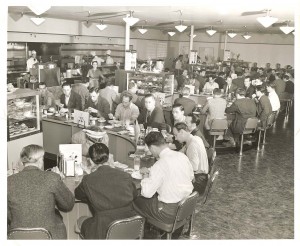 You should also check out Mark’s post of the FMPU Motion Picture Unit. Wow!
You should also check out Mark’s post of the FMPU Motion Picture Unit. Wow!
- Then, we also have to promote, once more, the excellent site A Film LA, Hans Perk’s blog. This is where the drafts for 101 Dalmatians orginally made it to the web, and there’s plenty more there as well. The more you dig, the more you’ll find. Where else could you find a photo of the Disney cafeteria shot in the 30′s? There’s always a great surprise.
Events &Hubley 25 Apr 2008 07:56 am
Jazz Scores at MOMA

- Tuesday night, the Museum of Modern Art had an event to celebrate the Wednesday opening of a new exhibition devoted to Jazz film Scores. This is what the invitation looked like.
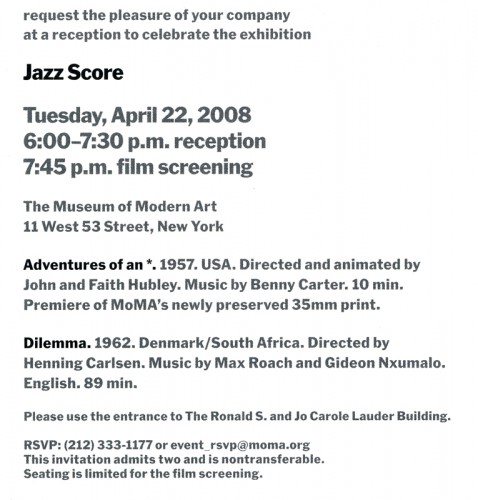
You can see from this that a main feature of the summer long exhibit of films will be Hubley shorts. The standout film is Adventures of an * in a brilliantly reconstructed print of the film. (I saw the film in 1963 in a theater, and I don’t remember the colors, even back then, looking as good as this print.)
With the film screenings is an exhibit of outstanding posters and a wall of artwork from Adventures of an *, including the start of the storyboard for the film.
The wall looks like this:

_____(Click any image to enlarge.)
I shot the image in parts and reconstructed it in photoshop. There’s some distortion due to the size and the fact that I was taking these pics on the sly; I don’t think photography is allowed.
Above this is the storyboard which feels somewhat like this (though I’m missing parts here.)
![]()
The board was near the ceiling so was hard to see, never mind photograph. Lots of light bouncing off it.
Here are some closer shots of the wall. Lighting was at its best, but it gives you an idea of what was there. The images here start to the left of the wall and move right.
Here are a couple of the images shot separately.
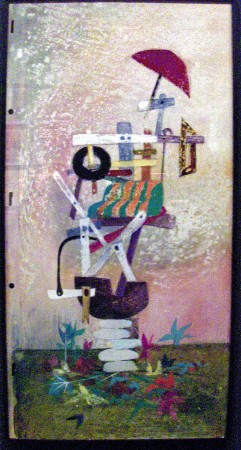 Quite a few of the backgrounds and setups from this film were framed and hung around the walls of the Hubley Studio, while I worked there. That alone made for glorious days just gawking at the stunning artwork.
Quite a few of the backgrounds and setups from this film were framed and hung around the walls of the Hubley Studio, while I worked there. That alone made for glorious days just gawking at the stunning artwork.
Needless to say, I was a Hubley fanatic before starting work there. I remember vividly that first day of opening the elevator door to be face to face with the beautiful blue rocking chair from Moonbird framed there in all its glory. I think it took me about five minutes to finally ring the doorbell, I was so entranced with John’s painting.
Part of the exhibitiion in the lobby is artwork from John Canemaker‘s beautiful short film, Bridgehampton. A sequence of paintings, that look like they emerged from an Oskar Fischinger film, grace the wall across from the Hubley images.
There’s also a very large video screen playing clips of both films in a loop. The quality, naturally, isn’t as good as the film print. Here’s the wall of John’s artwork, as well as a closeup of one of the images and a photo of him with me against the wall.

Here’s a photo of me up against the wall of Adventures of an *.
There’s also a reconstructed print of Tender Game whidch will play later in the summer. And, finally, below is the schedule for the animated shorts that will be playing through April and May.
The film exhibition runs through September, so you should keep up on the film programs.
I’ll try to update the schedule when I can.
Playing with the feature Dilemma is
Adventures of an *. 1957. USA. Directed and animated by John and Faith Hubley. Music by Benny Carter, with vibraphone solos by Lionel Hampton. 10 min.
____Friday, May 9, 2008, 8:15 p.m.
____Saturday, May 10, 2008, 3:00 p.m.
____Sunday, May 11, 2008, 2:30 p.m.
____Monday, May 12, 2008, 8:15 p.m.
____Wednesday, May 14, 2008, 8:15 p.m.
____Thursday, May 15, 2008, 6:15 p.m.
Playing with The Man With The Golden Arm is
The Three Little Bops. 1957. USA. Directed by Friz Freleng. Music by Shorty Rogers. A classic Looney Tunes cartoon. 8 min.
____Saturday, April 26, 2008, 2:30 p.m.
____Sunday, April 27, 2008, 4:45 p.m.
Playing with Odds Against Tomorrow is
Tal Farlow. 1950s/1980. New Zealand. Directed by Len Lye. Lye’s last cameraless scratch film, posthumously completed by Steven Jones, with a jazz guitar solo by Tal Farlow. 2 min.
____Sunday, April 20, 2008, 4:00 p.m.
Playing with Paris Blues is
Begone Dull Care. 1949. Canada. Directed by Norman McLaren, Evelyn Lambart. Award-winning abstract animation, with music by the Oscar Peterson Trio. 8 min.
____Saturday, April 19, 2008, 5:00 p.m., Theater 1, T1
____Wednesday, April 23, 2008, 6:15 p.m
Animation &Animation Artifacts &Hubley &Tissa David 01 Apr 2008 08:34 am
Letterman Flips the Ball
- Here’s an interesting short cycle that Tissa David animated for Letterman. Letterman, himself, plays with a football.
Tissa often animated on more limited shows this way. The drawings B1-B6 can work as a short cycle; drawings B1-D25 work as another cycle. She’ll move out of this and come back to it again later. It hides the cycles yet allows you to reuse drawings cleverly. It’s not just a constantly repeating 1-25 as appears here.
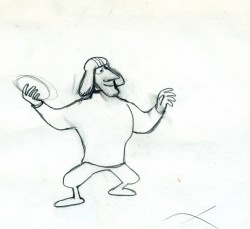 1
1 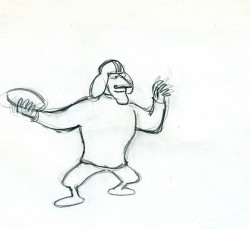 2
2
____________(Cick any image to enlarge to see full frame drawing.)
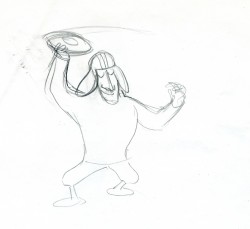 25
25Letterman flips the ball on threes.
Animation &Frame Grabs &Hubley 26 Mar 2008 08:23 am
Hubley Bumper
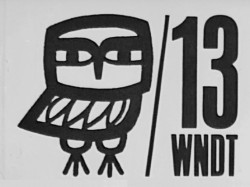 - One of my all time favorite pieces of Hubley animation was a station ID for WNDT-TV, New York’s public service station back in the 60′s. I thought of this spot last week when I posted the piece about Stanley Kaufman’s Art of Film for that station. It ultimately became WNET, NY’s PBS channel 13.
- One of my all time favorite pieces of Hubley animation was a station ID for WNDT-TV, New York’s public service station back in the 60′s. I thought of this spot last week when I posted the piece about Stanley Kaufman’s Art of Film for that station. It ultimately became WNET, NY’s PBS channel 13.
This spot was undoubtedly animated by Bill Littlejohn, and I think it’s one of his finest pieces. The timing is excellent. He obviously animated straight ahead; the characters distort and morph to the needs of the animation. It’s a full 2mins: 40 secs, so it would qualify as a short film these days,
The piece ran in B&W. It employed the multiple exposure technique. The characters had black paint filling everything bu the animation drawing. This was double exposed over the BG, hence a see-through quality to the characters. This techniques was used on Moonbird, The Hole, Of Stars and Men and several other Hubley shorts.
Here are some frame grabs of the spot.
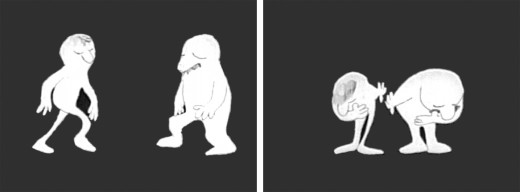
The two guys come out on to the stage and take a bow.
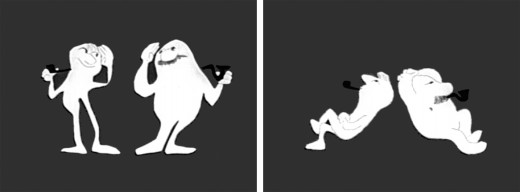
They greet each other, light up and sit down.
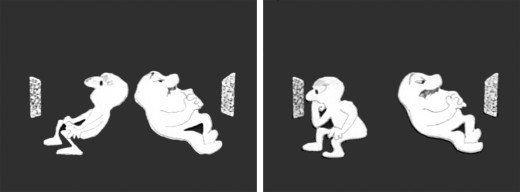
A little bored, they both turn on TV’s. The little guy gets involved.
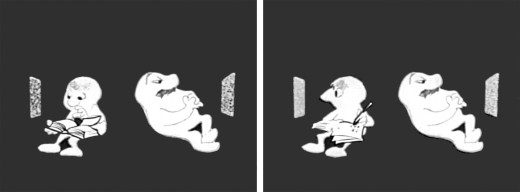
He takes out a book and takes notes comparing it with what’s going on his TV.
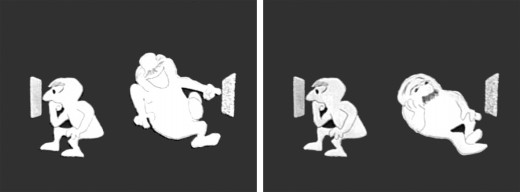
He goes back to watching. The big guy laughs at something until he gets bored again.
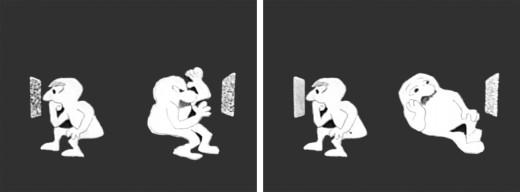
The big guy practices some wrestling moves until that gets dull.
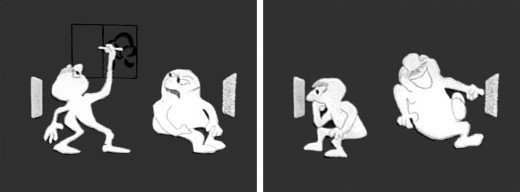
Little guy does some brush painting. Big guy laughs again.
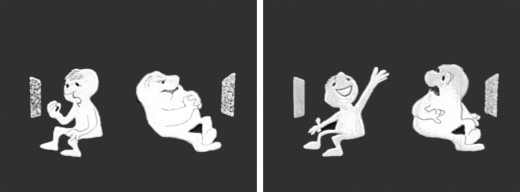
Little guy practices Russian. The big guy gets annoyed.
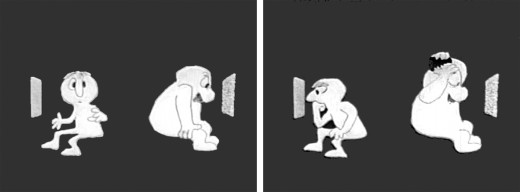
The big guy takes out a comb and starts combing until . . .
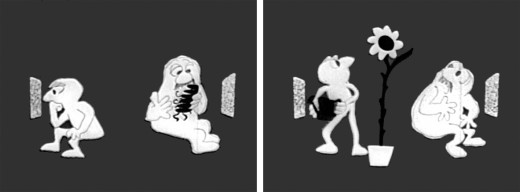
.. he has grease all over his head. The little guy grows a plant.
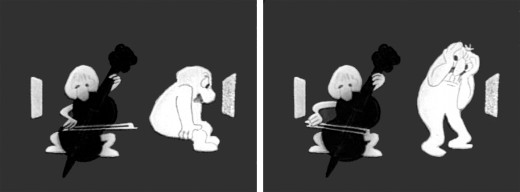
The little guy takes out a cello and starts to play. This annoys the big guy.
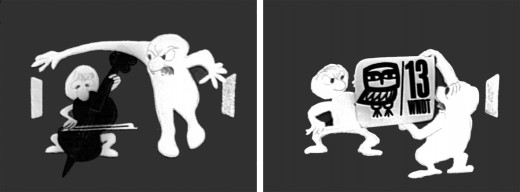
He pulls up the little guys screen. Public Television !
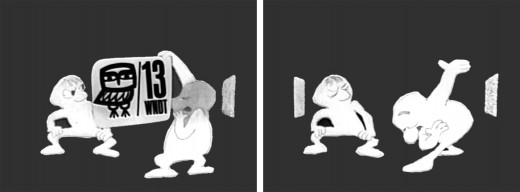
Embarrassed, he bows to the “Arts” station.
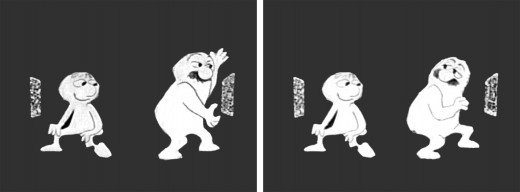
He turns to it on his own TV. He’s planning for something great.
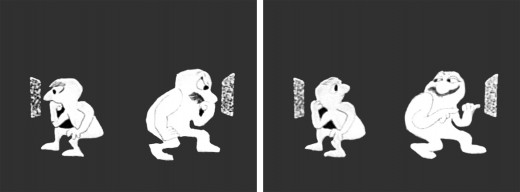
They watch intently until the big guy makes sure little guy knows he’s still watching.
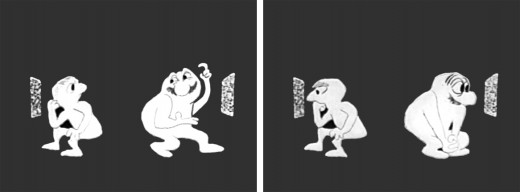
“Brain food” They watch intently.
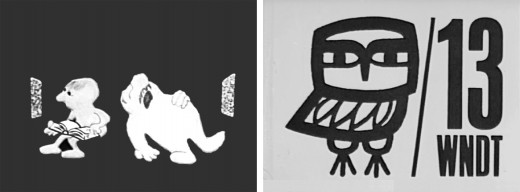
The big guy falls asleep while the little guy goes back to his book. Dissolve to station card.
I love how the shapes of the characters shift and distort and change throughout the piece always coming back to the original models. This is a sure sign of straight ahead animation, and it almost makes the acting feel like an improvisation exercise by two actors. It supercedes animation and becomes acting.
The obviously loose time of the piece shows that the animator was probably given a lot of leeway with his timing, and he took it. As I said, I have no proof that Bill Littlejohn animated it, but I’ve never doubted it for a moment. It’s certainly as much his style as it is Hubley’s.
That is the odd thing about working for a director with a strong personality. I remember the day that I looked at one of my drawings and realized that it looked like one of my drawings, but there was no doubt it was a Hubley. Something happens, and you just end up drawing in their style.
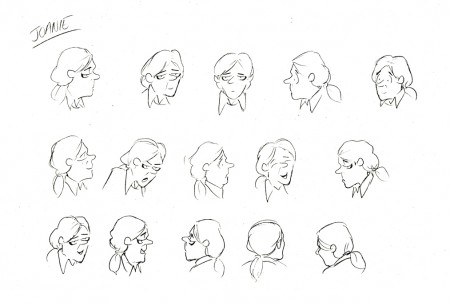
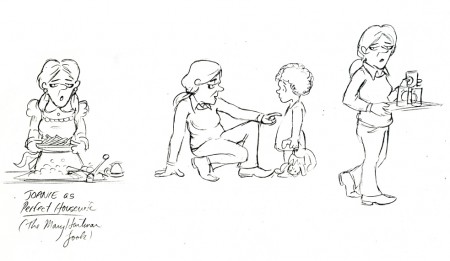
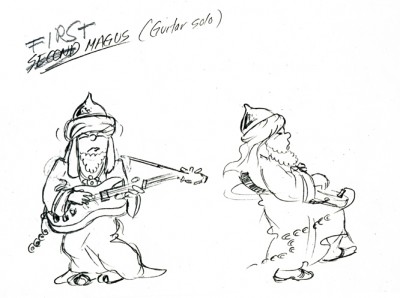
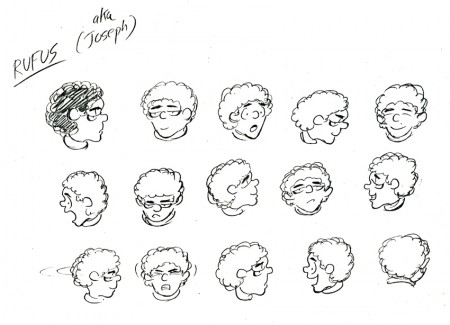
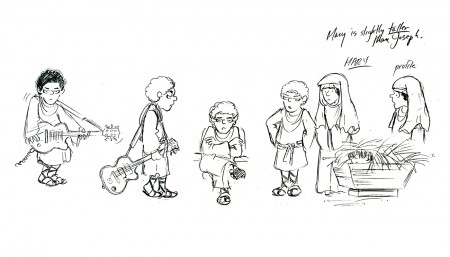
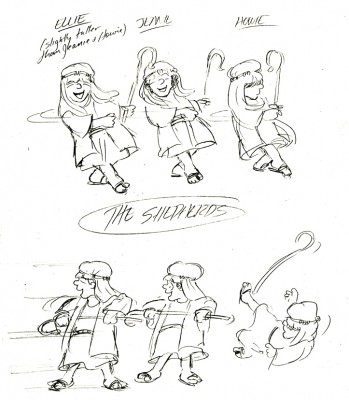
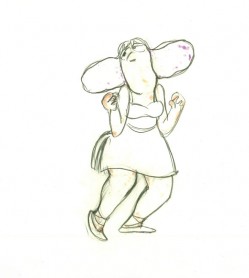
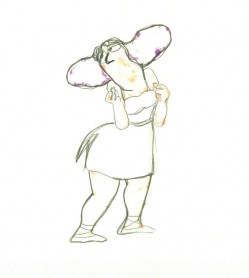
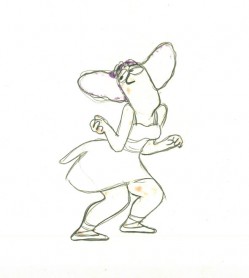
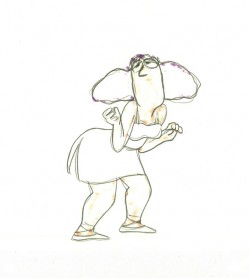
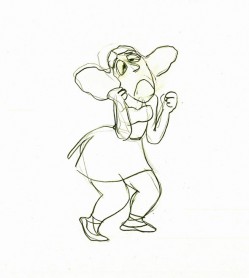
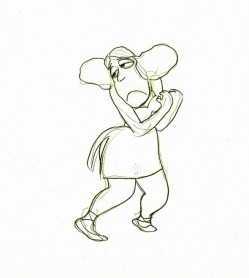
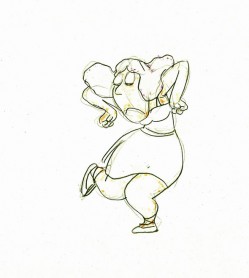
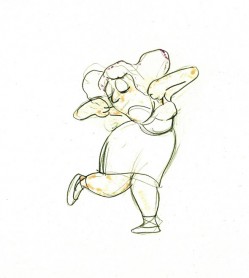
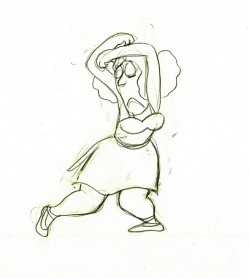
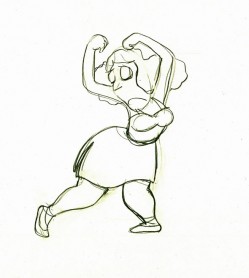
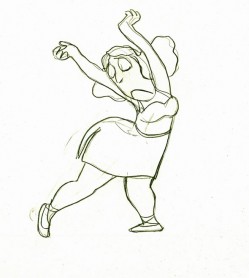
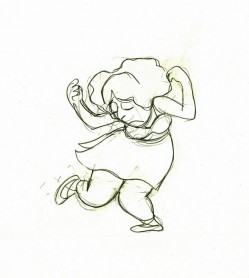
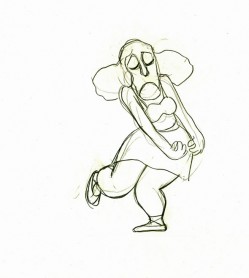
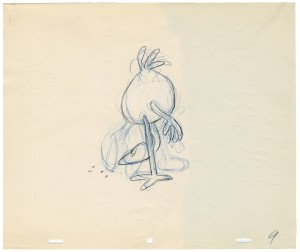
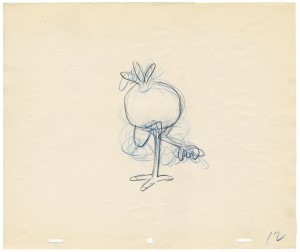
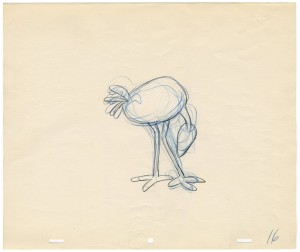

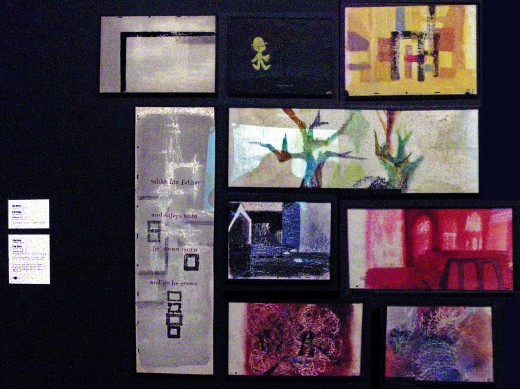 A
A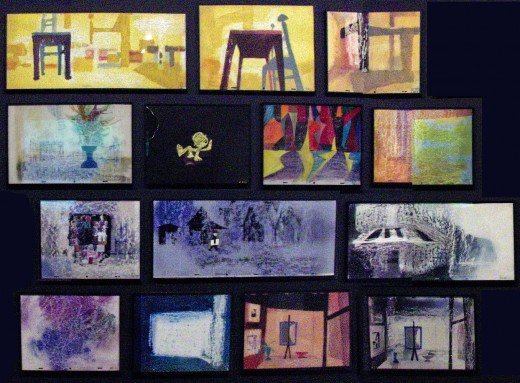 B
B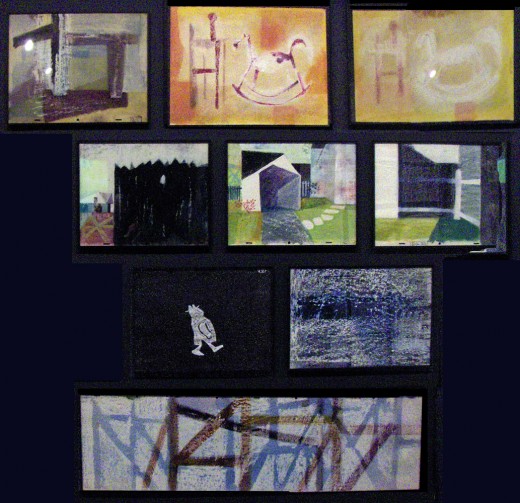 C
C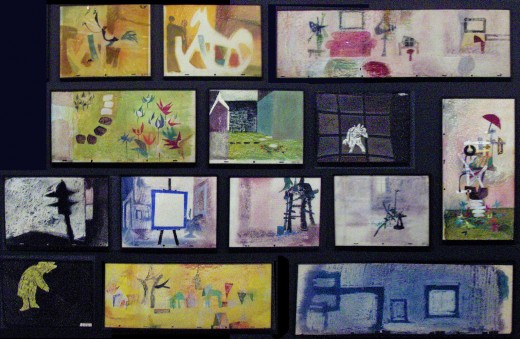 D
D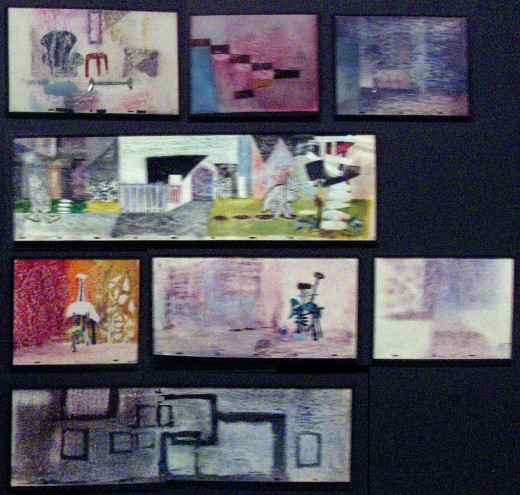 E
E
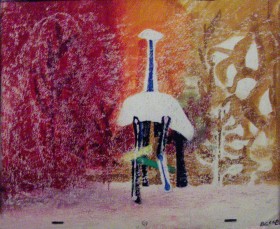
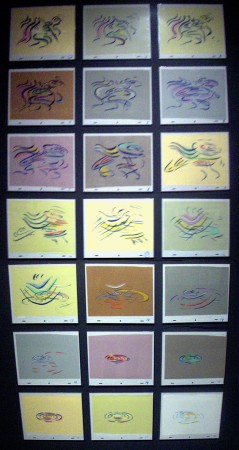
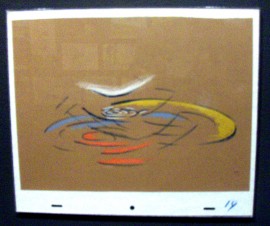
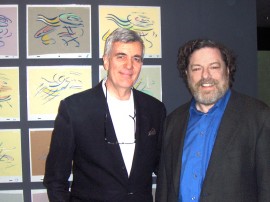
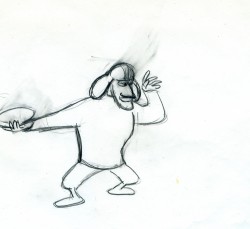 3
3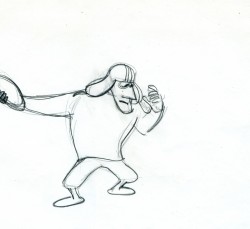 4
4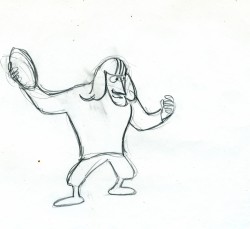 5
5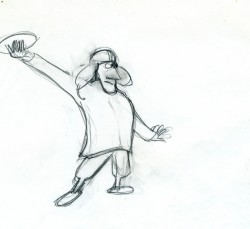 6
6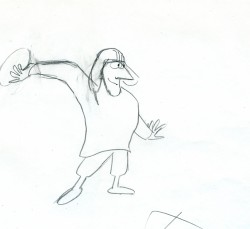 7
7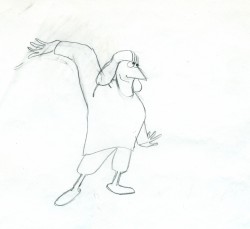 8
8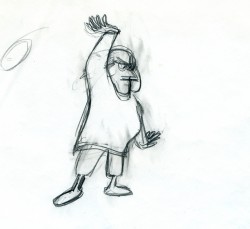 9
9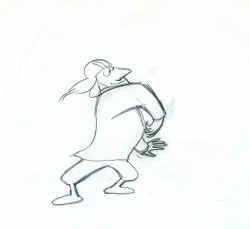 10
10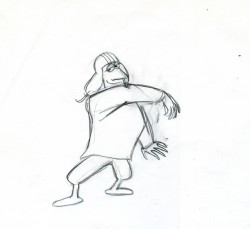 11
11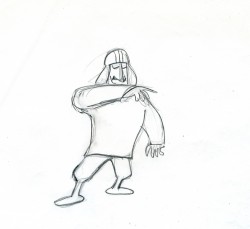 12
12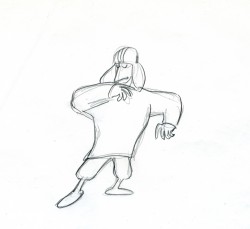 13
13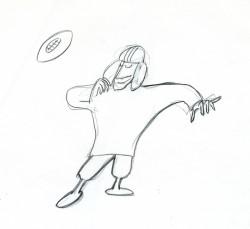 14
14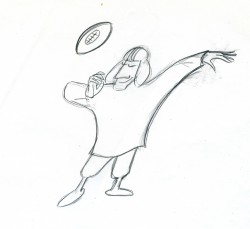 15
15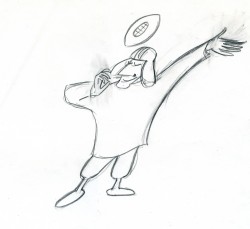 16
16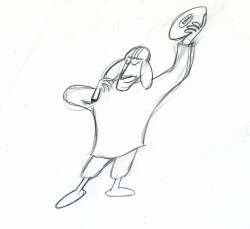 17
17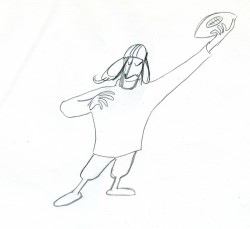 18
18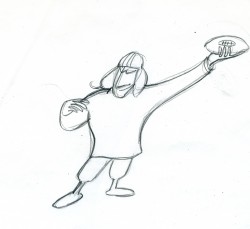 19
19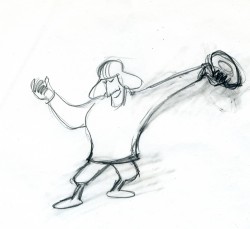 20
20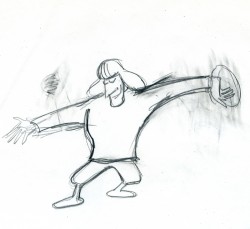 21
21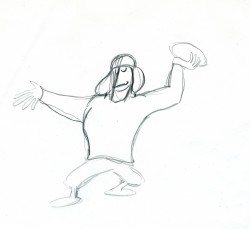 22
22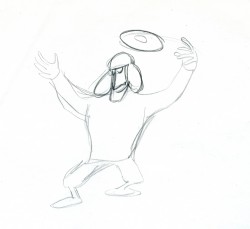 23
23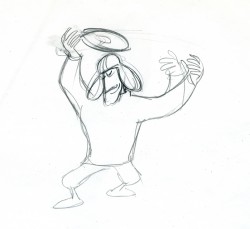 24
24